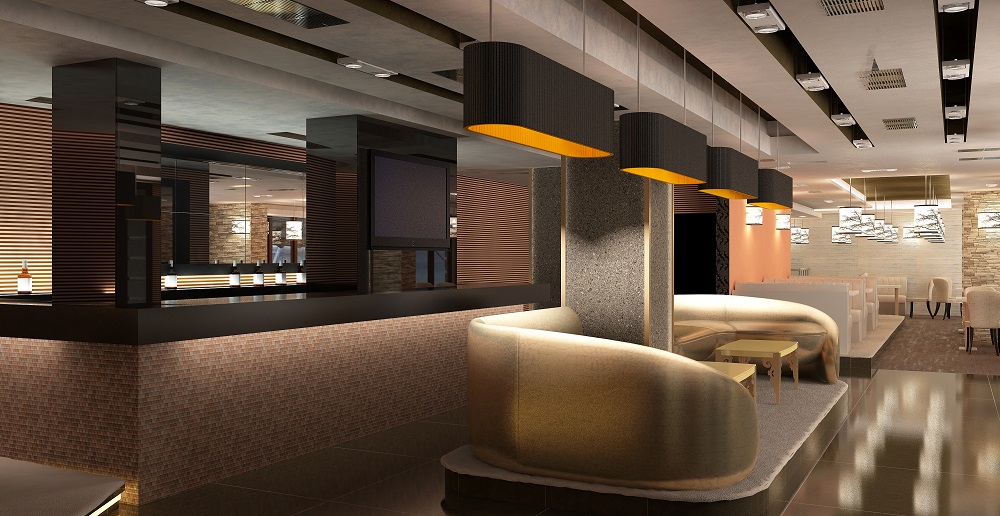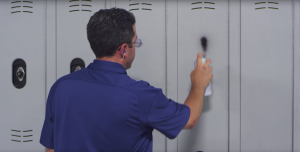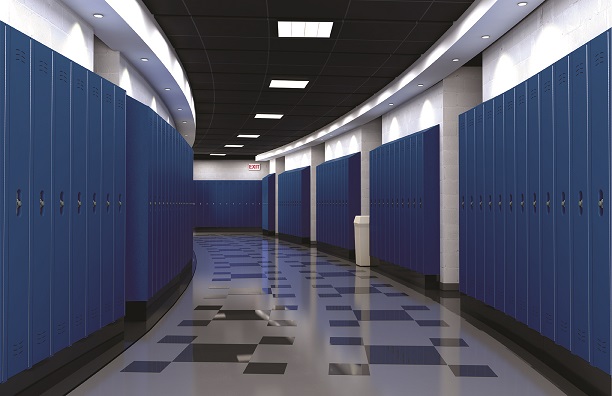Tag Archive for: locker rooms
As popular designs and trends are on the rise within specific industries, there’s one area that needs more attention than ever before. There is simply no better time to renovate run-down or outdated areas in public facilities. Two specific areas are locker rooms and restrooms. In 2023 and beyond, it’s more important than ever to provide a safe, private, modern, and inclusive design to your facility’s locker room or restroom.
So, when you’re thinking about what design trends to run with, what exactly are the biggest and most important reasons to update restrooms or lockers? Some may simply need to replace rusted lockers for better eye-appeal or safety concern since someone could get cut, others may need to take care of more challenging requests like plumbing issues creating damp environments which lead to rust and corrosion within the area. Or, some may want to upgrade for the benefit of a successful sports program to commemorate their home team. Whichever your reason for revamping your lockers or restroom partitions, it’s important for facility managers to keep in mind that these areas are more than just places to change, shower, and serve as functional public necessities—they can, in fact, complement your facility’s overall design scheme.
In this blog, we’ll discuss current design trends and what is working for the locker room and restroom partition industry based on a few factors of what’s been tried and true and rising in popularity with today’s society. Keeping these trends in mind will help your facility reap the benefits of HDPE plastic with Scranton Products brands.
Designed for Modernness & Privacy
Just because you’re looking for privacy doesn’t mean you have to forfeit a modern, sleek design that compliments the style of your restroom or locker room. Today, style and privacy go hand-in-hand, and everyone wants to feel comfortable in a private setting such as restrooms or locker rooms.
Scranton Products® Aria Partitions® are our full height partition and were developed to add enhanced comfort and privacy to your restroom design. Aria Partitions aesthetics combined with its solid HDPE material gives you a restroom design , and customizable to fit your project’s desired level of privacy and design.
Locker rooms are places that have a bad reputation because we often associate them with loud, slamming, rusty lockers from storing damp or sweaty items in. No matter what storage needs your facility has, Tufftec Lockers® have a solution. With a multitude of styles, configurations, and interchangeable options, you can create customized lockers that make the most of a space, while still giving you design options that complement your building in a durable HDPE material.
Restroom Partitions are Gender Inclusive
Co-ed dorms are on the rise, including gender-inclusive bathrooms in public facilities such as colleges and universities, now more than ever. Low privacy bathroom designs are a thing of the past! Instead, choose high-privacy restroom partitions that reduce sightlines and boastfully enclosed compartments that are not only attractive but also gender-neutral friendly.
We aren’t just talking about dorms and restroom facilities in high traffic areas, some students did not feel safe nor comfortable in their campus recreational facilities locker rooms because they were outdated, and not giving as much privacy as they would like. It’s important for these high-traffic facilities to accommodate the needs of others to feel safe and secure in a locker room or restroom that is meant for changing and private purposes.
Aesthetically Pleasing Designs
An attractive, sophisticated restroom partition or locker can make all the difference when it comes to the appearance of a commercial restroom or locker room. In fact, many facilities opt for slightly more expensive materials for their counters in order to create this quality look.
But did you know that higher quality materials, such as high-density polyethylene (HDPE) plastic, are often nonporous which means they’ll stay cleaner since HDPE is naturally germ resistant? This type of material may be slightly more expensive at the initial purchase, but the costs you’ll save in maintenance over the years making it less expensive in the long run.
When it comes to locker design, Scranton Products creates lockers and restrooms for strength and durability, all while keeping a modern, clean, and sophisticated design. The major difference between metal and HDPE lockers and partitions is the impact resistant properties that HDPE plastic holds. These products are also resistant to mold and bacteria, have low maintenance costs due to being power washable and steam cleanable, and offer the ability to choose from an array of styles for a custom locker or partition that matches your brand.
Sustainable Products
More and more companies are considering the carbon footprint they’re leaving and choosing sustainable products that are less harmful to the environment and better for the people in the facility. Some products give off emissions that reduce the quality of the air and can end up diminishing health.
Not only is HDPE plastic customizable, impact and moisture resistant, power-washable, easy to maintain, but Scranton Products® HDPE plastic also provides an extensive collection of colors and textures to choose from for your next restroom or locker room project.
When we are talking about restroom partitions, opting to choose plastic shoes and brackets increases the overall sustainability of your system by allowing the recycling process to become more streamlined at end-of-use, allowing for easier disposal. Not only do they both retain the same benefits offered by solid plastic materials, but they can be recycled all at once instead of being separated.
HDPE plastic can be made from recycled material and helps improve the air quality. This is especially helpful for restrooms and locker rooms that are heavily used, and are very easy to clean, and of course will never rust. And because HDPE plastic is solid color throughout, it never requires paint, so VOC emissions are avoided.
Focusing on Student Athletes
It’s to no surprise that school sports are a major part of a lot of students’ lives. Where the sport starts and ends is often in a Scranton Products Tufftec Lockers are engravable so you can show your school pride with your mascot or team logo, too!
What’s even more important with branding and mascot is recruiting visits for potential future players that are going to be representing the team and school. A cohesive design throughout a locker room is necessary in order to establish team-wide communication for those specific mascot and colors for the team’s history, community, and culture.
Hopefully now you have a better understanding of today’s current design trends for restroom partitions and lockers. It’s a given that we are focused on sustainability and privacy options now more than ever and it’s up to us to implement these needs into current design trends.

3d rendering of a restaurant interior design
Color and texture are essential elements of design; they add personality and just the right amount of zest to create your own distinct creation. They help define a space while influencing our moods and behaviors. Designers use these elements to create contrast and depth, express emotion, and to create rich sensory experiences that stimulate our collective senses.
Color Trends Influence Industry
Color psychology studies the effect that different hues have on human behavior, and using specific colors in design to evoke different emotional responses is a trend that is gaining momentum. Color trends influence a wide variety of industries, and many organizations commit substantial resources to researching and identifying current color trends. Some of the paint manufacturing leaders such as Sherwin-Williams®, and Benjamin Moore® conduct significant research and commit their resources to identifying color trends. The Pantone Color Institute has chosen “Greenery” Pantone 15-0343 as their 2017 Color of the Year, as it evokes spring and renewal, while representing the global movement towards sustainability and protection of the environment.
Providing Visual Contrast With Texture
The combination of color and texture conveys a distinct experience, so the right mix is key to the overall design. Today’s designers are mixing up trendy monochromatic palettes with interesting textures to add contrast and dimension to a space. One of the hottest texture trends in the residential and commercial flooring market is the use of rich, dark wood grain; while sleek metallic finishes are very much on trend in both residential and commercial applications.
We are seeing lines blurring when it comes to residential and commercial usage of metallic textures, such as chrome, nickel, and stainless steel. Black stainless steel and champagne metallic finishes have transitioned from their initial use in residential kitchens and are now widely being used in commercial interiors to add subtle luster and sophistication.
On Trend For Commercial Restrooms
When considering design for public restrooms, architects and designers have many opportunities to incorporate color and texture in order to create a space that meets their aesthetic vision. In these spaces, they are also challenged to balance aesthetics with safety and durability, as well as the comfort and privacy of the user.
Scranton Products are innovators when it comes to commercial bathroom partition solutions. Our Eclipse Partitions® combine sleek and modern style with high privacy and high durability, offering rich color and texture options that are precisely on trend, such as textured nickel, bronze, black metallic and stainless steel.
Part of the beauty of these high-design partitions is that they are built using sustainable building materials, making them the right choice for your facility and the environment. The solid core design requires no painting, is very low maintenance, and the materials are non-porous, and resistant to bacteria, mold and mildew, making them the smart choice for busy public facilities and high traffic settings.
To view the range of color and texture options available in Eclipse Partitions®, please click on the link below.
As a facility manager of a school, nothing is as stressful as ridding an area in the school of recently applied graffiti. There can be debates of what constitutes as art, but there’s no denying that graffiti is vandalism. While art should be left in the classroom with washable materials being used, you’re tasked with finding ways to combat this problem and ensure that it doesn’t continue. You’ll need to implement a zero-tolerance policy to graffiti vandalism in your school.
Here are a few steps on how to work towards stopping graffiti from popping up in your school.
Communicate with School Administrators About the Costs
As the facility manager of the school, you don’t have any disciplinary sway with the students, so you’ll need to address these issues to the administrators and/or principals. Remind them that graffiti is not only an act of vandalism, but it’s costing you money and time with maintenance. If they can come up with a disciplinary plan that can thwart students from marking up the walls and other components in your school, you’ll begin to see a drop in “artwork” from appearing in your school.
Focus on the Problem Areas
The most common place that you’ll find graffiti is on the toilet partitions. Students with graffiti aspirations use these stalls as their springboard because it’s enclosed and private. However, you can stop graffiti in its tracks by utilizing the right materials for your bathroom.
stalls as their springboard because it’s enclosed and private. However, you can stop graffiti in its tracks by utilizing the right materials for your bathroom.
HDPE plastic toilet partitions are resistant to graffiti. They won’t absorb any paint or permanent marker. Once any mark is made, it can easily be wiped away without having to invest in some fresh paint to coat over the graffiti.
Take Away the Graffiti Hotspots
This step requires you to think like a graffiti artist. You need to look out for easy targets, like blank walls, and even elevated areas that can be viewed by everyone in the school. To combat the students’ desire to tag these spots, beat them to the punch and paint the walls with a darker color that makes it less appealing to spray an image or phrase on.
Update Your Lockers
Lockers are another target area for students to mark up. Since most lockers are made from steel, you’ll have to repaint them once graffiti pops up. However, HDPE plastic can also be used for lockers. This will save you the cost and time that goes into painting, all while updating your schools lockers with a strong, durable, and graffiti-resistant material.
Utilizing HDPE plastic materials has a wide variety of benefits. When it comes to combatting graffiti, these lockers will help you save money and time on maintenance because they resist paint. Once graffiti appears on any HDPE locker or partition, it can easily be wiped away. Want to learn more about HDPE plastic and the many benefits there are to choosing it for your school? Check out this blog post, Why HDPE is a Super Material, from your friends at Scranton Products.
At Scranton Products, we’re more than happy to help any interested party learn more about HDPE plastic lockers, and why they’re a smart choice and a suitable material for your school or facility. In order to help you learn as much as possible about these lockers, we’ve assembled this plastic lockers FAQ page. We encourage you to look below to the relevant question to see if the answer helps you.
Are HDPE Lockers Durable?
Yes! HDPE (high-density polyethylene) plastic lockers have been proven to be more durable than traditional metal lockers. Due to their solid plastic construction, HDPE lockers are more impact-resistant than standard lockers. They won’t even dent or scratch. They’re also resistant to humidity and moisture, making them a valuable storage compartment in locker rooms or other damp areas of your school or facility. They’ll resist mold growth, as well as rust, so you don’t have to worry about costly replacements or repairs.
Do HDPE Lockers Require a Lot of Maintenance?
Because of the durable construction, HDPE lockers require very little maintenance. They’re guaranteed to last up to 20 years without any problems. The only maintenance that they require is a simple cleaning now and again. Imagine how much time and money you’ll save on maintenance! They essentially pay for themselves after a few years.
Are These Lockers Difficult to Assemble?
Installing these lockers is quick and easy. By following the instructions, you’ll see a fast and efficient installation process. With a little help, you can install all your lockers in one day.
Are HDPE Plastic Lockers Secure?
HDPE lockers are customizable, offering you many different options as to what type of locking system works best for you. Duralife lockers come with either an inset combination lock or a hasp. Tufftec lockers provide numerous options like padlocks, keys, in-door combinations, and even an RFID digital lock.
How Big Are HDPE Lockers?
These lockers don’t have a set size. You can actually customize the size and tiers that you want, depending on the needs, as well as the space allotted in your school or facility.
Do HDPE Lockers Need to Be Painted?
HDPE lockers don’t require you to paint them. They’re available in multiple designs, as well as homogenous colors. Any signs of graffiti can simply be wiped away, without you having to paint your lockers. Not only will this save you the effort, but you won’t be risking your air quality with the VOC (volatile organic compound) emissions released by paint.
What Are the Benefits of Choosing HDPE Lockers?
There are numerous benefits to choosing HDPE lockers. They’re durable, low-maintenance, cost-effective, long-lasting, and sustainable. They’re also considered green building materials, so you can get started on making your school or facility more sustainable by utilizing HDPE plastic lockers. These eco-friendly lockers would make a great addition to your school or facility.
Want to learn even more about HDPE lockers and the many benefits? Check out our Duralife lockers.
The technological, virtual and physical landscape of the public school system has changed and advanced in many ways since the beginning of the new millennium. We have seen new products, and changes to the services and standards in the educational space evolve over the last 20 years. Add to that the way a student learns in school, as well as how they interact with their educational environment, and the conditions are ripe for change. Here, we are highlighting a few key trends that are relevant to driving school design and shaping it to fit 21st century learning.
Technology And Learning
Many public schools are repurposing the additional space within classrooms that used to house bulky computers and wiring. With the advancements in wireless technology, the PCs are replaced with slimmer laptops and devices that students can easily transport inside and outside the classroom. Desks with power ports are being installed to better access the technology. This additional mobility allows for more versatility in how and where a student learns.

Converting Corridors Into Public Spaces
Where hallways were once the main thoroughfares, in some public schools those corridors are being modernized to make way for common seating areas. These areas are proving to be a positive addition to the social and educational behavior of the students.

Flexible Configurations In The Classroom
The traditional square classroom with uniform desk setup is evolving as well. No longer are students and teachers relegated to a desk and chair in a set matrix. Many schools are opting for a flexible learning area where the layout allows for an easier flow into adjoining spaces. Having the ability to rearrange the configuration in a classroom is allowing teachers to foster collaboration and encourage group learning.
Goal to Go Green
Many schools across the country have committed to using sustainable products and making smart use of resources. They are also selecting materials that support excellent air quality and a healthy indoor environment for students. Many schools are taking their commitment very seriously and are working towards a LEED (Leadership in Energy and Environmental Design) Certification.
Sustainable Solutions
Scranton Products Duralife Lockers® are the sustainable solution for schools looking to support a healthier environment. Our HDPE products are made in part from recycled materials and are 100% recyclable, helping to reduce environmental impact. The solid color needs no painting, so our products have a zero volatile organic compound (VOC) emissions rating, offering initial and long-term improvements to the indoor air quality of your projects. Duralife Lockers® are GREENGUARD Gold Certified, which meet the strict certification requirements for use in schools and can contribute to LEED certification.
Click to see where you can buy the right sustainable products near you. https://www.scrantonproducts.com/
When you’re choosing the lockers for your school or facility, there are a variety of factors at play that you need to consider, not just for the immediate future, but for the long term. Choosing the right material for your lockers is crucial if you want to have functional storage compartments, but you’ll also want durable lockers that’ll last the years so you can get the most out of them without having to ensure a costly replacement years down the line. Making the right decision can end up saving you the costs for replacements and even maintenance. Learn more about the lifecycle cost of your lockers and the difference in cost between metal and HDPE lockers over time.
Choosing the Right Materials
Metal lockers have been the standard for a long time due to their durability, but they’ve received some criticism over the years because of the constant upkeep and maintenance that they require. Lately, some facility managers have been gravitating toward HDPE (high-density polyethylene) lockers because of the low-cost maintenance, durability, and their longevity. But in order to make the decision, you need to learn the benefits of both materials.
Metal Lockers vs HDPE Lockers
Both metal and HDPE lockers provide a strong construct that can last a long time and perform effectively for years. However, as most facility managers have learned, metal lockers are actually susceptible to a variety of factors and issues that can result in costly and recurring maintenance. HDPE requires very little maintenance over the years, resulting in less costs and a longer lasting material.
Metal lockers are susceptible to mold growth. Whether it’s in the locker room, or a lengthy corridor, moisture and humidity will cling to the metal. Over time, unsightly mildew will begin to sprout, resulting in a foul smell and a drop in air quality. Ridding the lockers of mold and mildew can be a costly and repetitive endeavor.
HDPE materials, on the other hand, are made of solid plastic. Mold can’t penetrate its thick construction, and its exterior is impervious to humidity and moisture. HDPE lockers are also resistant to impacts, scratches, and dents, and even graffiti can be eradicated with a simple wipe.
Benefits of HDPE Lockers
There are numerous benefits to choosing HDPE lockers over metal ones. The most obvious is cost. Metal lockers require a lot of maintenance and upkeep over the years, whereas HDPE lockers don’t require extensive repairs of cleaning. In a study conducted over 20 years, HDPE has been proven to not only last longer, but require less maintenance. Within two years, HDPE lockers are less expensive than metal lockers.
Because of the low cost of maintenance with HDPE lockers, you don’t have to repaint them. This has the added benefit of keeping VOCs (volatile organic compounds) emissions out of your facility’s air. HDPE lockers are also less noisy than metal lockers, without the loud clanging whenever the lockers are shut. If you’re looking for low-maintenance, cost-effective, and long-lasting lockers, then HDPE is one of your best options.
Want to learn more about the benefits of HDPE lockers? Read The Ultimate Guide to HDPE Plastic Lockers, courtesy of Scranton Products.
